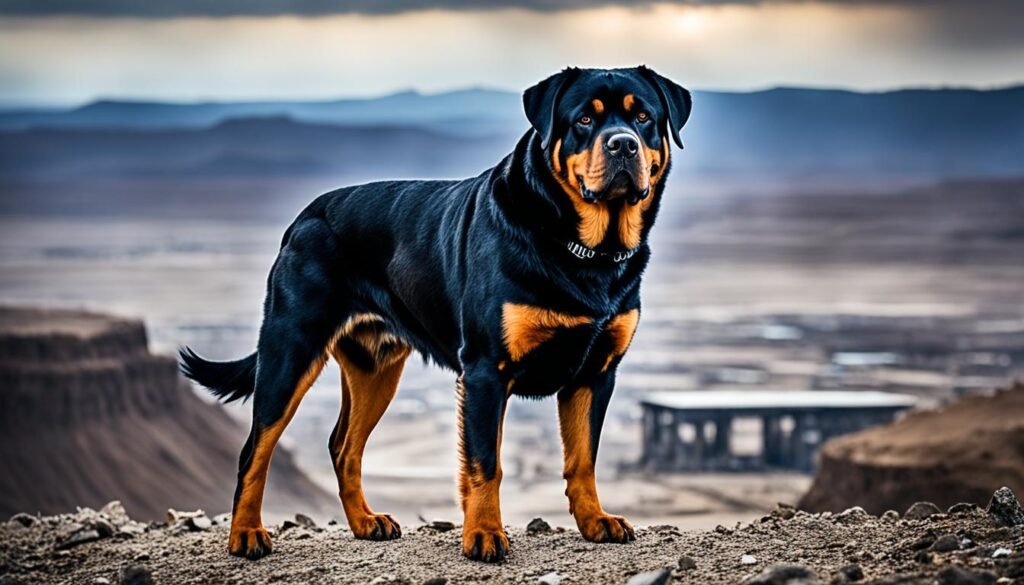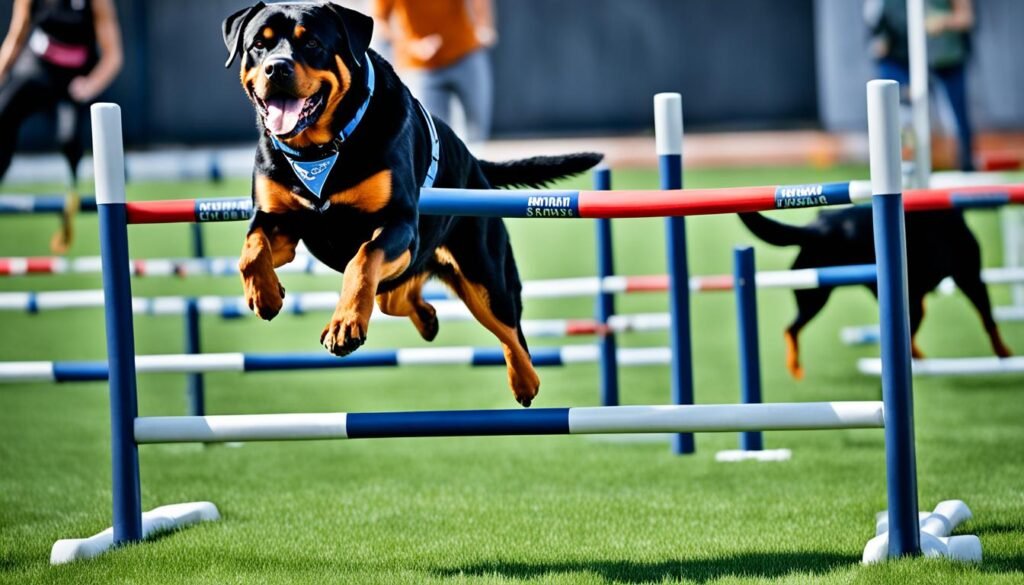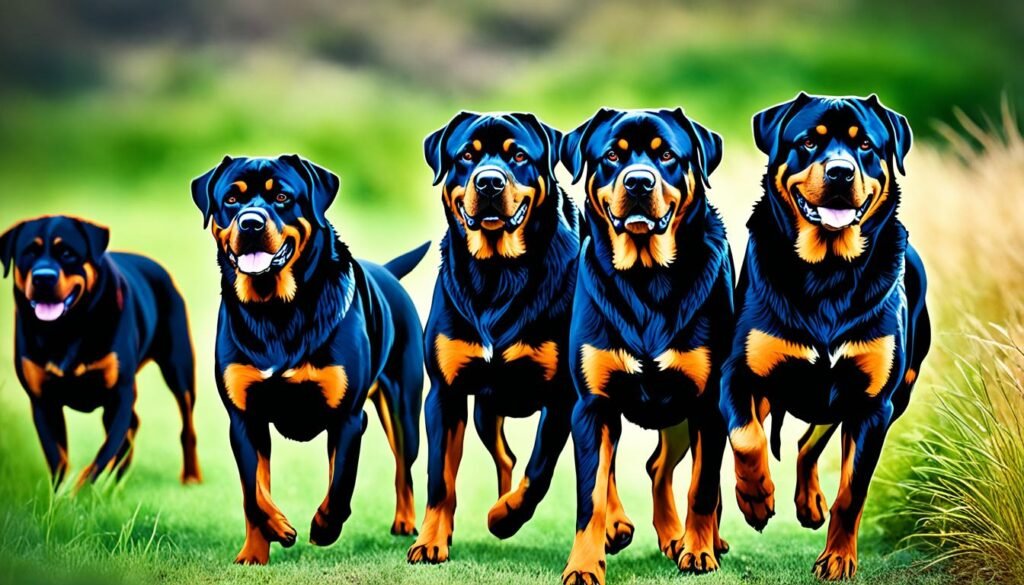Did you know that Rottweilers, the strong and enduring breed we know today, almost faced extinction? At one point in their history, their population declined to the point where they were on the brink of disappearing entirely. Let’s explore the fascinating story of how Rottweilers narrowly escaped extinction and went on to become the beloved breed they are today.
Key Takeaways:
- Rottweilers’ population declined significantly, putting the breed in danger of extinction.
- A breed club was formed in the early 1900s to preserve and promote the Rottweiler breed.
- Rottweilers have a rich history as working and companion dogs.
- Conservation efforts are being made to maintain the genetic diversity of Rottweilers.
- Rottweilers have a confident and loyal temperament but require proper training and socialization.
Rottweiler Genetic Diversity and Conservation Efforts
In recent years, there has been increasing concern about the genetic diversity of Rottweilers and the need for conservation efforts. With the breed’s small population and limited gene pool, there is a risk of inbreeding and the associated health problems. To ensure the long-term health and vitality of the Rottweiler breed, responsible breeders are implementing breeding practices focused on maintaining genetic diversity and avoiding excessive inbreeding.
By carefully selecting breeding pairs and considering factors such as health, temperament, and conformation, breeders strive to produce offspring with a wider range of genetic traits. This approach helps to minimize the risk of genetic disorders and preserves the breed’s overall health.
Additionally, conservation efforts involve promoting the adoption of responsible breeding practices within the Rottweiler community. Encouraging breeders to collaborate and share information, such as health records and genetic test results, helps to make informed breeding decisions and ensures the propagation of healthy Rottweilers.
Conservation efforts also extend beyond breeders to education and awareness campaigns targeted towards Rottweiler owners. By educating owners about the importance of responsible ownership, breeding practices, and the impact of genetic diversity on the breed’s sustainability, a collective effort can be made to protect and preserve endangered Rottweilers.
Through these collaborative conservation efforts, the Rottweiler breed can maintain a healthy population and genetic diversity, safeguarding them from the brink of endangerment. It is crucial that we continue to prioritize the well-being and future of this remarkable breed.
Rottweiler Breed Preservation and History

The Rottweiler breed’s history is closely intertwined with its preservation. As previously mentioned, Rottweilers faced the threat of near extinction when herding cattle became illegal. However, their remarkable versatility and unwavering loyalty contributed to their resurgence as both working and companion dogs. Today, dedicated efforts are being made to honor the breed’s history and safeguard its working abilities through various activities such as obedience trials, herding trials, and protection sports.
It is through these activities that we celebrate the Rottweiler’s heritage and maintain its essential working traits. Obedience trials showcase the breed’s ability to follow commands with precision and responsiveness. Herding trials tap into the Rottweiler’s natural instinct to protect and guide livestock, preserving their indispensable herding abilities. Protection sports demonstrate their unwavering loyalty and courage, highlighting their aptitude for safeguarding their loved ones.
By engaging in these pursuits, Rottweiler enthusiasts and breeders ensure that the breed’s remarkable history and working capabilities are treasured and passed down to future generations. The dedication to breed preservation is vital not only for maintaining the unique traits and characteristics of Rottweilers but also for appreciating the breed’s fascinating journey from the brink of extinction to their esteemed position today.
Rottweiler Temperament and Characteristics

Rottweilers possess a confident and fearless temperament that is a hallmark of their breed. These strong and athletic dogs have a natural instinct to protect their families, making them excellent guard dogs. Despite their imposing appearance, well-bred Rottweilers can also be gentle and loving companions. Their loyalty knows no bounds, and they are renowned for their devotion to their loved ones.
Proper socialization and training are essential in shaping the temperament of Rottweilers. From a young age, it is important to expose them to various people, animals, and environments to ensure they develop into well-rounded dogs. With proper guidance, Rottweilers become well-behaved and respectful animals in any setting.
Rottweilers have a solid and balanced temperament that makes them suitable for various roles. They excel as working dogs due to their intelligence, strength, and endurance. From herding and guarding to search and rescue work, Rottweilers are versatile and highly trainable.
Additionally, Rottweilers make loyal and affectionate companions for individuals and families alike. They form deep bonds with their owners and are known to be extremely protective. However, it is important to note that responsible ownership is crucial, as Rottweilers require proper training, socialization, and guidance to reach their full potential.
Overall, Rottweilers possess a combination of strength, loyalty, and intelligence that sets them apart. With the right upbringing and care, these remarkable dogs can thrive in various roles and provide unwavering devotion to their loved ones.
Rottweiler Health Concerns and Care

As owners of Rottweilers, we must prioritize their health and well-being. Like all dog breeds, Rottweilers are susceptible to certain health concerns that require our attention and proactive measures. By addressing these issues, we can ensure that our beloved Rottweilers live long, healthy lives.
Common Health Concerns in Rottweilers
- Dental Disease: Rottweilers are prone to dental problems such as gum disease and tooth decay. Regular brushing, dental cleanings, and providing appropriate chew toys can help maintain their oral health.
- Infections: Rottweilers may develop infections, including ear infections and skin infections. Ensuring good hygiene, regular grooming, and seeking prompt veterinary care for any signs of infection are essential.
- Obesity: Rottweilers have a tendency to gain weight, which can lead to various health issues like joint problems and heart disease. A balanced diet and regular exercise are important to keep them fit and maintain a healthy weight.
- Parasites: Rottweilers can be vulnerable to parasites such as fleas, ticks, and worms. Regular preventive medications and routine veterinary check-ups can help prevent infestations and minimize the risks associated with parasites.
- Genetic Predispositions: Some Rottweilers may have genetic predispositions to certain health conditions, such as hip dysplasia and heart problems. Responsible breeding practices and regular health screenings can help identify and manage these potential issues.
Please consult with your veterinarian for a comprehensive understanding of the health concerns specific to your Rottweiler. They can provide tailored advice and guidance based on your Rottweiler’s needs.
Lifespan and Care
Rottweilers typically have a lifespan of 8 to 10 years. However, with proper care and attention to their health, they can live longer. Regular veterinary check-ups, vaccinations, and preventive medications are crucial in maintaining their overall well-being.
Additionally, responsible spaying and neutering contribute to their health and help prevent certain reproductive-related health issues. This decision should be made in consultation with your veterinarian.
Remember, as responsible owners, we play a vital role in keeping our Rottweilers healthy and happy. By understanding the specific health concerns associated with the breed and implementing appropriate care practices, we can ensure that our Rottweilers thrive and enjoy a high quality of life.
Rottweiler Training and Socialization

Training and socialization are vital aspects of shaping well-rounded Rottweilers. As a responsible owner, it is essential to start training and socializing your Rottweiler puppy from a young age to ensure they grow up to be confident and well-behaved adults.
One key aspect of Rottweiler training is the use of positive reinforcement methods. Reward-based training techniques, such as treats, praise, and play, are highly effective in motivating Rottweilers and reinforcing desired behaviors. This approach helps establish a strong bond between you and your dog while making the training experience enjoyable for both.
Consistency is equally crucial in training Rottweilers. Establishing a consistent routine helps your Rottweiler understand what is expected of them and promotes better learning and behavior. By maintaining a regular schedule for feeding, exercise, and training sessions, you can create a structured environment that promotes positive development.
Clear leadership is another vital aspect of training Rottweilers. Rottweilers are intelligent and strong-willed dogs that require confident and assertive leadership. By establishing yourself as the pack leader through consistent training, boundaries, and clear communication, you can foster a sense of respect and obedience in your Rottweiler.
To ensure proper socialization, expose your Rottweiler puppy to various people, animals, and environments. This helps them become comfortable and confident in different situations. Gradually introduce new experiences, such as meeting new dogs, visiting the park, and encountering different sounds and sights. Positive interactions during socialization provide your Rottweiler with important life skills and help prevent behavioral issues in the future.
Obedience training is an essential part of Rottweiler training. Teaching basic commands like sit, stay, come, and heel not only ensures your Rottweiler’s safety but also enhances their overall obedience and responsiveness. Leash training is another important aspect, allowing you to establish control and prevent pulling or other undesirable behaviors during walks.
In conclusion, training and socialization form the foundation for a well-behaved and confident Rottweiler. By using positive reinforcement techniques, maintaining consistency and clear leadership, and prioritizing obedience training and socialization, you can set your Rottweiler up for a happy and well-adjusted life. Remember, a properly trained and socialized Rottweiler is not only a joy to be around but also a responsible representation of this remarkable breed.
Conclusion
The journey of the Rottweiler breed from the brink of extinction to its present state is a testament to the resilience and dedication of breed enthusiasts. Through conservation efforts, responsible breeding practices, and a focus on maintaining genetic diversity, Rottweilers have not only survived but thrived. Their confident and loyal temperament has solidified their position as beloved companions and working dogs.
However, it is crucial for owners to prioritize the health of their Rottweilers. Regular veterinary check-ups, proper dental care, vaccination, and preventive medications are fundamental in ensuring their well-being. Additionally, providing effective training and socialization from a young age is vital to shaping their behavior and ensuring they become well-adjusted members of society.
As responsible stewards of the Rottweiler breed, it is our duty to honor its history and preserve its unique traits. By maintaining their physical and mental health, investing in proper training, and promoting responsible ownership, we can continue to cherish and benefit from this remarkable breed for generations to come.
FAQ
Did Rottweilers almost go extinct in their history?
Yes, the Rottweiler breed had a close call with extinction in its history.
What is the Rottweiler breed’s history?
The Rottweiler breed originated in Germany and was used for herding and guarding cattle.
What caused the decline in the Rottweiler population?
The decline in the Rottweiler population was due to the decrease in the popularity of herding cattle.
What are the conservation efforts for Rottweilers?
There are conservation efforts in place to protect and promote the Rottweiler breed’s population.
Why are Rottweilers considered endangered?
Rottweilers are considered endangered due to their small population and limited gene pool, which poses risks of inbreeding and associated health problems.
What breeding practices are implemented to maintain genetic diversity in Rottweilers?
Responsible breeders are implementing breeding practices focused on maintaining genetic diversity and avoiding excessive inbreeding in Rottweilers.
How was the near extinction of Rottweilers prevented?
The formation of a breed club in the early 1900s played a crucial role in preventing the near extinction of Rottweilers and preserving the breed.
What are the characteristics of Rottweilers?
Rottweilers are known for their strength, endurance, and confident and fearless temperament. They are strong, athletic dogs with a natural instinct to protect their families.
Are well-bred Rottweilers gentle and loving companions?
Yes, well-bred Rottweilers can be gentle and loving companions, despite their imposing appearance.
What are some common health concerns in Rottweilers?
Common health concerns in Rottweilers include dental disease, infections, obesity, parasites, and genetic predispositions.
How can owners keep their Rottweilers healthy?
Regular veterinary check-ups, proper dental care, vaccination, preventive medications, and responsible breeding practices can help keep Rottweilers healthy.
What is the importance of training and socialization for Rottweilers?
Training and socialization are crucial for the development of well-rounded Rottweilers. They help shape their temperament and ensure they are well-behaved and respectful.
How has the Rottweiler breed been preserved?
The Rottweiler breed has been preserved through conservation efforts, responsible breeding practices, and a focus on maintaining genetic diversity.
